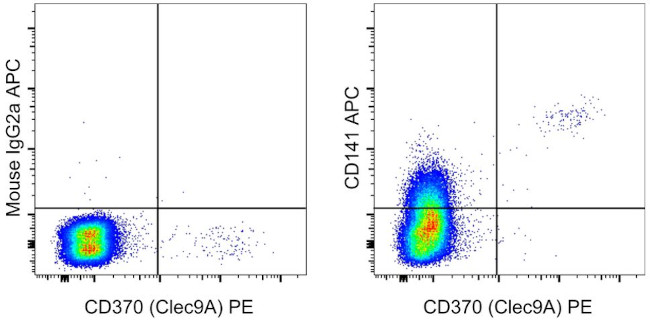Search Thermo Fisher Scientific
Invitrogen
CD141 Monoclonal Antibody (JAA17), APC, eBioscience™
FIGURE: 1 / 1
CD141 Antibody (17-1419-42) in Flow

Product Details
17-1419-42
Species Reactivity
Published species
Host/Isotype
Recommended Isotype Control
Class
Type
Clone
Conjugate
Excitation/Emission Max
Form
Concentration
Purification
Storage buffer
Contains
Storage conditions
Shipping conditions
RRID
Product Specific Information
This JAA17 monoclonal antibody recognizes human CD141 also known as thrombomodulin, fetomodulin, or BDCA-3. CD141 is a type I membrane receptor that binds and allosterically activates thrombin. The resulting complex cleaves protein C and the Thrombin Activatable Fibrinolysis Inhibitor (TAFI), initiating an important anticoagulant and anti-fibrinolytic pathway. Soluble thrombomodulin is constitutively present in the serum at a very low level and can be upregulated during inflammation. The anti-inflammatory activity of thrombomodulin results from its ability to block the highly pro-inflammatory activity of thrombin. Thrombomodulin prevents chemotaxis and binding of granulocytes to activated endothelium and inhibits activation of eosinophils and mast cells thereby reducing inflammation. Mutations in the CD141 gene result in thromboembolic disease, also known as inherited thrombophilia. Although expressed across many tissues and cell types, its highest expression has been reported on the luminal surface of vascular endothelial cell. In the immune system the highest expression can be observed on myeloid cells, including dendritic cells, macrophages and blood monocytes. In humans, CD141 is commonly used as a marker of cross-presenting dendritic cells in both lymphoid and non-lymphoid tissues. Retinoic acid has been shown to upregulate CD141 expression on human monocyte-derived dendritic cells and primary human dendritic cells.
The JAA17 antibody will recognize CD141 on cells that have been formaldehyde-fixed and permeabilized.
This JAA17 antibody has been pre-titrated and tested by flow cytometric analysis of normal human peripheral blood cells. This can be used at 5 µL (0.125 µg) per test. A test is defined as the amount (µg) of antibody that will stain a cell sample in a final volume of 100 µL. Cell number should be determined empirically but can range from 10^5 to 10^8 cells/test.
Filtration: 0.2 µm post-manufacturing filtered.
Target Information
Thrombomodulin (TM) is also known as Fetomodulin (FM), endothelial anticoagulant protein, or glycoprotein P112. Thrombomodulin contains six repeated domains homologous with epidermal growth factor (EGF) and an amino terminal domain homologous to lectin-like protein. Through its accelerated activation of protein C, synthesis of TM is one of several mechanisms important in maintaining thrombo-resistance and thus reducing clot formation on the surface of the endothelial cells. Immunohistochemical staining of formalin-fixed tissue for TM has been used for the study of a variety of vascular tumors, meningiomas and choriocarcinomas.
For Research Use Only. Not for use in diagnostic procedures. Not for resale without express authorization.
How to use the Panel Builder
Watch the video to learn how to use the Invitrogen Flow Cytometry Panel Builder to build your next flow cytometry panel in 5 easy steps.
Bioinformatics
Protein Aliases: BDCA-3; CD141; CD141 antigen; DC141; Fetomodulin; sCD141; soluble CD141; Thrombomodulin; TM
Gene Aliases: AHUS6; BDCA3; CD141; THBD; THPH12; THRM; TM
UniProt ID: (Human) P07204
Entrez Gene ID: (Human) 7056

Performance Guarantee
If an Invitrogen™ antibody doesn't perform as described on our website or datasheet,we'll replace the product at no cost to you, or provide you with a credit for a future purchase.*
Learn more
We're here to help
Get expert recommendations for common problems or connect directly with an on staff expert for technical assistance related to applications, equipment and general product use.
Contact tech support

